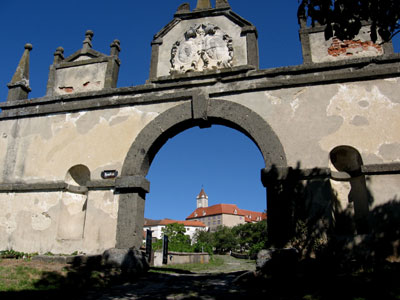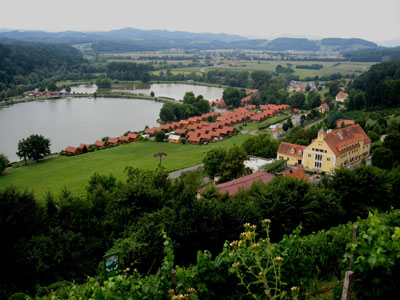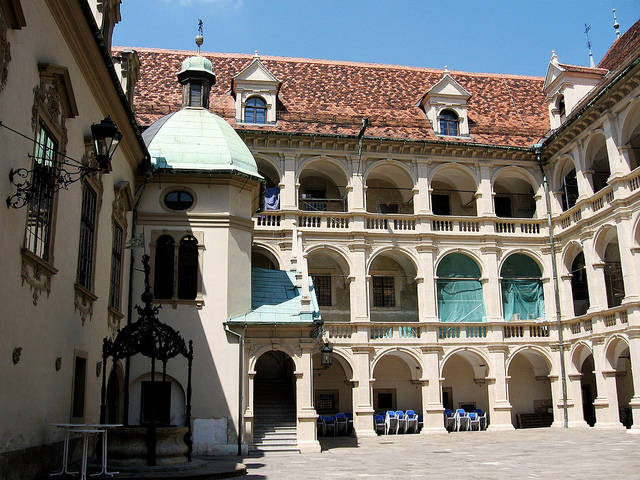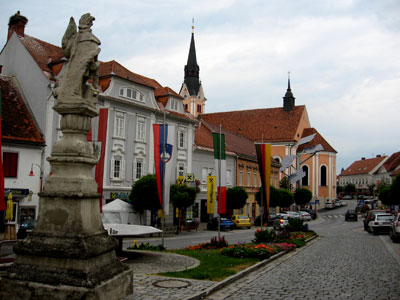The name of the Riegersburg fortress was originally mentioned in 1138 as “Ruotkerspurch”, which actually means “Rüdiger’s castle”, so the fortress originally belonged to an aristocrat by that name. It underwent major reconstruction during the late 16th century to include late Renaissance architectural features. The large ceremonial rooms and the arcade in the inner courtyard date back to this era.

Moving into the interior of the fortress
Two permanent exhibitions are being hosted in the Riegersburg: the “Witch Museum” in the cellar focuses on the obsession with and persecution of witches which had gripped Central European countries from about 1450 until 1750. About 300 presumed witches and sorcerers were persecuted in witch trials in Styria and many of them were executed. The peak of the witch-hunting frenzy took place during the 30 Years’ War from 1618 to 1648 when the war and the so-called “minor ice age” had destroyed agriculture and decimated the population, much of which of course was blamed on the evil doing of supposed witches.

One of the inner courtyards of the fortress
We were planning to see the other exhibition: “Legendary Riegersburg – Legendary Women”. Two very colourful female characters are associated with the history of this fortress. The first one was Baroness Elisabeth Katharina von Galler (1607 to 1672) who was the lady of the castle from 1648 to 1672. In a time of very traditional male-female role expectations the “Galllerin” was a very unconventional character and strayed from the usual norms. Women, even aristocratic women, were not allowed to own property at the time, and Elisabeth, as the sole heiress of the fortress, would have had to relinquish any property ownership to her husband, but she refused to comply. Even in her prenuptial agreement she ensured the right to decide over her property herself.

Some family portraits
Baroness Elisabeth von Galler initiated a complete reconstruction of the fortress which included the stunning baroque White Hall as well as the construction of the numerous bastions, gates and the extensive walls surrounding the castle. Several inscriptions above different gates point out that she spent a lot of money on this construction work. Her husband incurred major debt and in 1649 she paid him out with a substantial sum of money and got rid of him. Altogether Baroness von Galler was married three times and involved in several legal battles with her husbands, and local clergy.

A coat of arms adorns another gate
The other interesting female character featured in the “Legendary Women” exhibition is Katharina Paldauf who was an employee of Baroness von Galler for whom she started working at 20 years of age. From 1673 to 1675 she got embroiled in the Feldbach Witch Trial and was accused of having manipulated weather and participated in witch Sabbaths.The legends also say that she was able to grow roses in winter, a talent that earned her the moniker “the flower witch”. For her supernatural powers to grow flowers in the off-season she was accused being a witch and was presumably executed in 1675.

The baroque splendour of the White Hall
Various displays in the exhibition also shed light on the historical background of the 16th and 17th centuries. Servitude and feudalism characterized the power structures during the Middle Ages, and peasants had a very difficult life while aristocrats formed a hereditary elite that was entitled to hold lands and exercise far-reaching powers over the common people. The mostly agrarian economy at the time obligated peasants to deliver a substantial share of their production to the local lords and noblemen who in turn promised them protection during periods of war. This was an era of extensive exploitation and lords had the right to use peasants’ land as they pleased. Often a peasant would require the permission of a lord when he intended to marry, and onerous taxes were imposed on the peasant class. These harsh conditions actually led to many peasant rebellions throughout Central Europe in the 16h century.

The beautiful coffered ceiling of the Hall of Knights
The noblemen on the other hand lived a lavish lifestyle. An inscription at the entrance of the fortress indicates that an excessive feast during the 1600s resulted in 21 days of binge eating and drinking. The opulently decorated Knights Hall was the location of many such bouts and a wooden bridge connecting it with another hall was used for relieving oneself after all this carousing and is commonly referred to as the “vomiting bridge”. Even today the figure of a man bent over adorns the bridge, reminding people of its original purpose.

The “vomiting bridge”




